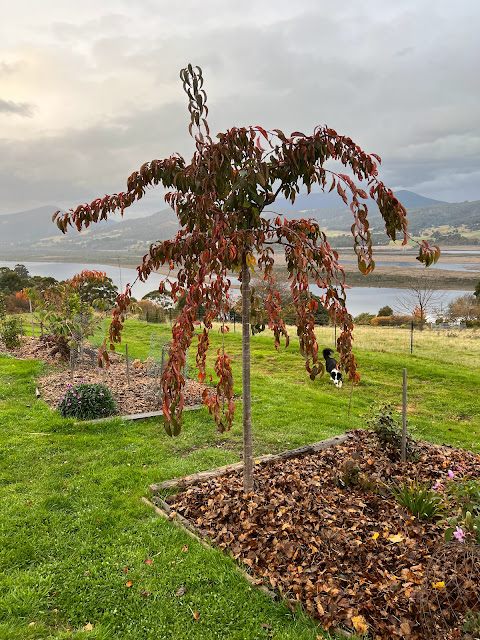A case of apophenia ...
One of the first big changes we made in the garden at Cracroft Farm was to build a garden bed along the side of the drive. We planted 4 Pyrus Calleryana (ornamental pear) trees which we hoped would give us vivid colour in the autumn, lovely white blossom in the spring and a nice upright structure in the summer. Thus far the trees have fulfilled the last requirement in spades, but they stubbornly keep their green leaves in autumn and almost all the way through the winter, meaning that their blossom in spring is somewhat muted! I have made a point of studying all of the many ornamental pears in and around Huonville, trying to discern a pattern of colouring (location, height above sea level etc.) that might explain the behaviour of our trees, but nothing substantive has yet emerged from this study.
In a similar but different vein, we now have 7 Prunus Serrulata (ornamental flowering cherry) trees in various locations around the garden: Weeping Cheals, Prentice Dancer, Mount Fuji, Pink Perfection (x2), Taihaku and Shirofugen. Unlike the ornamental pears, the cherries appear to be colouring up but at vastly differing rates. I have analysed things like distance to the nearest structure, date planted and age of the bed into which they were planted to find the key, but as yet my research has been fruitless (often the case with fundamental research, a feature that I have encountered repeatedly in my academic career!).
Early in the week, however, I received absolution from this purgatory. I was doing some desultory reading on a wet and wild day when I came across a word I had never encountered before - apophenia. Apparently, apophenia was coined by Klaus Conrad, a German psychiatrist, in 1958 to describe a psychological phenomenon characterised by the tendency to perceive meaningful patterns or connections in random or unrelated data, or alternatively, seeing things that aren’t there. Conrad initially introduced the term in the context of schizophrenia, suggesting that apophenia was a feature of the disorder. Of course, this bit of trivia got me more than a little worried. I then discovered yet another word I had never heard of before – pareidolia – which specifically refers to the perception of familiar images or patterns in random stimuli. Apparently common examples of pareidolia include seeing faces in clouds, animals in random patterns, or images in textured surfaces like wall stains. I have now ceased my research aimed at trying to explain the behaviour of the colour of leaves in autumn with immediate effect, before I really start seeing things. I have promised myself that I will embrace the randomness … for the moment anyway.
Since the sudden and tragic demise of Maverick, our two remaining geese (Goose and Iceman) have adopted the neighbours’ dam as their sanctuary. About every third afternoon they make their way down to the cottage and honk their heads off until we oblige them by taking some wheat up to the top paddock for them to devour. They then wait until dark and make a dash back to the dam. This strategy seems to be working well for them and they both seem fit and healthy.
Unfortunately, the same cannot be said for our young guinea fowls (keets). We have been raising 6 keets in the hope that as adults they will control the ticks in the paddock which seem to have taken a liking to Knut. Not for nothing are they known as nature’s vacuum cleaners when it comes to bugs. Currently we have them housed in the orchard and for the last couple of weeks we have been letting them out of their cage by day to roam around and get used to being outside. Today yet another tragedy unfolded while we were out having a celebratory lunch to mark Cath’s birthday. On our return, we found the remains of one of the keets in a corner of the orchard; presumably the victim of another raptor attack, although this time the perpetrator must have been a lot smaller than a wedgetail eagle. Luckily whatever it was that struck the guinea fowl ignored the much larger and tastier hens in an enclosure adjacent to the orchard. I really hope that we are not getting a fast-food reputation among the local raptor population! I am even more concerned that there may be a pattern emerging …







Comments
Post a Comment